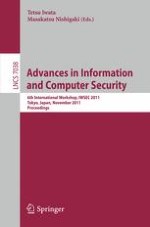This book constitutes the refereed proceedings of the 6th International Workshop on Security, IWSEC 2011, held in Tokyo, Japan, in November 2011. The 14 revised full papers presented in this volume were carefully reviewed and selected from 45 submissions. They address all current issues in information and computer security such as foundations of security, security in networks and ubiquitous computing systems, and security in real life applications. The papers are organized in topical sections on software protection and reliability; cryptographic protocol; pairing and identity based signature; malware detection; mathematical and symmetric cryptography; public key encryption.
